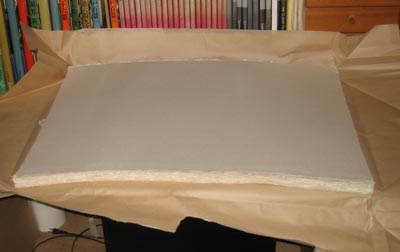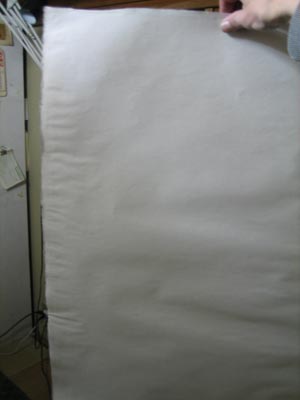Today's postings
- [Baren 37907] gold leaf (Cucamongie # aol.com)
- [Baren 37908] p.s. on gold leaf (Cucamongie # aol.com)
- [Baren 37909] Re: p.s. on gold leaf (Barbara Mason)
- [Baren 37910] Re: New Baren Digest (HTML) V46 #4673 (Jan 13, 2009) ("Shelley Hagan")
- [Baren 37911] Re: gold leaf (Sharri LaPierre)
- [Baren 37912] Re: metallics-- some thoughts (ArtSpotiB # aol.com)
- [Baren 37913] Re: 2-up carving (Dave Bull)
- [Baren 37914] Baren Member blogs: Update Notification (Blog Manager)

Message 1
From: Cucamongie # aol.com
Date: Tue, 13 Jan 2009 14:59:18 GMT
Subject: [Baren 37907] gold leaf
Send Message: To this poster
Mica is lovely and sparkly but does not look anything like gold leaf. Also,
metal leaf has quite a different look from gold leaf. Mica, gold leaf and
composition leaf are all wonderful but they have very different qualities as
far as surface goes. If you are going to purchase it, try to go to a store
where they can show you samples.
Barbara, that is interesting about the composition leaf that you had. must
be a special kind, because, for example, a friend recently covered a box with
metal leaf and in a few short months it already started to tarnish in areas
that were not properly coated with varnish. the type of metal leaf I have
seen costs approx. $6 for a book of 25 leaves. The leaves for composition leaf
are larger in size than the ones for gold leaf. Gold leaf I have seen for
anywhere from around $40-60 per booklet of 25.
good luck and have fun!
Sarah

Message 2
From: Cucamongie # aol.com
Date: Tue, 13 Jan 2009 15:02:50 GMT
Subject: [Baren 37908] p.s. on gold leaf
Send Message: To this poster
be varnished in order to keep from tarnishing. As for putting varnish of
some kind over metal leaf, silver leaf etc on delicate waterbased prints, I
believe there are some sprays you can use but I have not had experience using
these sprays.
Sarah

Message 3
From: Barbara Mason
Date: Tue, 13 Jan 2009 15:31:09 GMT
Subject: [Baren 37909] Re: p.s. on gold leaf
Send Message: To this poster
Barbara

Message 4
From: "Shelley Hagan"
Date: Tue, 13 Jan 2009 16:50:12 GMT
Subject: [Baren 37910] Re: New Baren Digest (HTML) V46 #4673 (Jan 13, 2009)
Send Message: To this poster
a no-no to lay out a block with two of the same layer, essentially just
making a 2-up woodblock, making printing twice as fast? I'm not planning on
editioning these so the small differences between the two carvings wouldn't
be an issue there. I'm planning on printing about 100 of these and being
able to print two cards off the same block would speed up the process a
great deal.
Having worked as a graphic designer, laying out this way seems logical. I
don't know printmaking etiquette too well though. Does anybody do this? Is
it okay or considered tacky? Your input would be appreciated.
Shelley

Message 5
From: Sharri LaPierre
Date: Tue, 13 Jan 2009 18:07:49 GMT
Subject: [Baren 37911] Re: gold leaf
Send Message: To this poster
I used the metal leaf (gold, but not the real stuff) on a print many
years ago, and again as background on one not too many years ago. I
have had no tarnishing or other problems with either print. I applied
it exactly as the gal in the video on youtube, except it was on
paper. Did not put a protective coat over the foil. Both are oil
based prints and can be seen on my website.
http://web.mac.com/barebonesart/iWeb/barebonesart/unequal%20equals.html
http://web.mac.com/barebonesart/iWeb/barebonesart/tea%20at%20tel%20el%20armana.html
In both cases the leaf was applied to bare paper - I do not recommend
applying it over ink as may not adhere properly and the chemicals
beneath it may have an adverse effect. The foil I used was purchased
at Art Media (a local art materials store). It seems expensive, but
actually it lasts a long time because if you're careful you can use
every last teensy bit of it. Let the foil dry in place and then
remove the excess with a soft bristle brush. I used paper under the
area where I was applying it so that I could easily recapture small
pieces and either use them on the piece or return them to a plastic
bag for another time.
Hope this helps - feel free to write if you have questions.
Cheers & Happy New Year, everyone!
Sharri

Message 6
From: ArtSpotiB # aol.com
Date: Tue, 13 Jan 2009 21:27:43 GMT
Subject: [Baren 37912] Re: metallics-- some thoughts
Send Message: To this poster
And to all the others in this discussion. So exciting to read what everyone
has to say in this area.
Moongold, eh? hmmmm. Sounds yummy.
Thanks everyone!
ArtSpot Out
Benny in studio
"It is neither wealth nor splendor, but tranquility and
occupation, which give happiness."
--Thomas Jefferson

Message 7
From: Dave Bull
Date: Tue, 13 Jan 2009 22:32:51 GMT
Subject: [Baren 37913] Re: 2-up carving
Send Message: To this poster
> essentially just making a 2-up woodblock, making printing
> twice as fast?
More than one print on a block is very common here, in two forms:
- two (or three) different prints side by side on a larger block. Print
them all together, then trim apart for distribution.
- identical designs side-by-side. Usually 2-up, and usually postcard
size. Takes extra carving time (although not quite double), and
printing goes literally twice as fast.
All the prints in my Hanga Treasure Chest were done with the first
method.
Dave
Digest Appendix
Postings made on [Baren] members' blogs
over the past 24 hours ...
Subject: Fun and Games with the paper ...
Posted by: Dave Bull
|
Carving work on the 'Seacoast in Winter' print is steadily progressing, interrupted as usual by any number of other jobs competing for attention. Today saw a pretty big one of those ... A couple of months back, I did an inventory of my paper stock for this series, to work out how many more sheets I needed in order to complete the rest of the series, and placed an order with Iwano-san for them - 150 sheets of Echizen Hosho washi, in the 'takenaga' dimension. They arrived a few days ago, along with the bill, for 236,000 yen ... (around $2600 US at today's exchange rate ...)  The paper in this 'raw' state cannot be used; it must be sized. This is a special skill all its own, and I will send this package straight off to Misawa-san, the last craftsman here in Tokyo who still does this work. At least that's what I should be doing; unfortunately the process is no longer quite so simple. Here is a sample of a sheet from the previous batch of this same type of paper, which he sized for me just over a year ago:  Incredible. The sizing was hard, brittle and uneven. The sheets were dried too quickly and became severely buckled and distorted. I called him right away to find out what had happened, but he had no excuse. It seems though, that the problem lay in the large width of these sheets. Sizing must be done in one continuous brush stroke across each sheet, and he has a collection of very large brushes for just this purpose. But a brush this wide - full of hot size - is very heavy, and he is not so young ... It is also possible (this is just a guess) that his large brushes are getting worn out, and as he is nearing retirement, and a brush of this width would cost a great deal of money to have made to order, he is using them beyond the point where they can do the job properly. Whatever the reason, the batch of paper had been effectively destroyed. Ordering more was out of the question; to throw away that much money was just not possible. I had to try and use it. I cut the paper into the smaller dimension required for the prints, and tried to salvage what I could. I used a shallow pan with warm water, soaked each sheet to try and wash out some of the size, and then dried each one on boards. I got most of the worst of it out, but all through the rest of the printing work on the next few prints, kept getting results like this when I dried out the finished print: [Long item has been trimmed at this point. The full blog entry can be viewed here] |
This item is taken from the blog Woodblock RoundTable.
'Reply' to Baren about this item.
Subject: Sketch Book Project
Posted by: Kathe Welch
 The Art House Co-op in Atlanta, Georgia invited artists from around the world join in a sketchbook marathon...The books will tour for several months. I hope the come to the San Francisco Bay Area so that I can see what everyone else did... Check out the rest of my drawings, as I add them! |
This item is taken from the blog Kathe Welch.
'Reply' to Baren about this item.